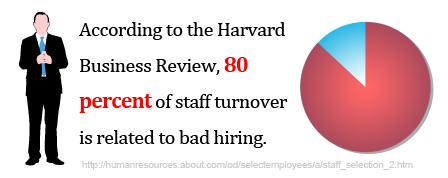 Some employers are paralyzed by the fear that they will make a bad hire. That is understandable, given that making a mistake in the hiring process can cost them considerable time and money. According to the Harvard Business Review, 80% of employee turnover can be in some way attributed to poor hiring decisions. So what can you do to increase the chances that you will choose an employee who will work out well for you? Here are some hiring tips:
Some employers are paralyzed by the fear that they will make a bad hire. That is understandable, given that making a mistake in the hiring process can cost them considerable time and money. According to the Harvard Business Review, 80% of employee turnover can be in some way attributed to poor hiring decisions. So what can you do to increase the chances that you will choose an employee who will work out well for you? Here are some hiring tips:
1.) Matching personalities to positions
Some supervisors have found it useful to come up with a list of the personality attributes needed for a job, and then seek people who fit those attributes. For example, if you are looking for a salesperson, you need somebody who is friendly and easy to like, yet driven to close the sale. For somebody who is going to be working what may be considered a tedious job, like crunching numbers or computer coding, an introverted person may be a better fit than somebody who loves to talk. Spend a little time thinking about what type of personality would be the best fit for your job opening, and hire accordingly.
2.) Read people’s resumes thoroughly
All too often, managers and human resources executives simply scan a resume, or use resume scanning software, looking for particular keywords to find qualified people. They may miss negative signals on resumes. For example, if a potential staffer switches jobs every year, that person may not be likely to be someone who will stay at your company for the long haul. Typos on a resume can show a lack of attention to detail. A long, rambling resume could reflect a rambling personality behind it. So pay attention to what a resume says and what it doesn’t say, such as long gaps between jobs.
3.) Multiple interviews with multiple people
Even the most incompetent person may be able to pull the wool over one interviewer’s eyes in a single interview. This is why it is critical not just to have multiple interviews with a future staffer, but to have multiple people interview the person. Different people may pick up different things from the jobseeker, and gathering intelligence from a variety of sources could prove to be fruitful.
4.) Give the candidate a tryout
If you are able to, see if you can have the would-be employee do a tryout at your company. Some businesses do this by hiring temporary workers, and then deciding whether to hire them full-time. Others give job candidates a project to work on, pay them for it, and hire whoever does the best job on it. For example, a company hiring a graphics designer could ask candidates to create a logo. Getting to see not just a future employee’s work, but the person’s personality in the workplace, could save supervisors from making a crucial hiring mistake.
5.) Check references
Many businesses neglect to do this, something they may find that they regret. Make the calls to references, and notice what they say, and what they don’t say. For example, if they give one-word, noncommittal answers about a person’s talents, keep that in mind, because that could mean they are reluctant to say many positive things about the candidate. In addition, LinkedIn makes it easier than ever to reach out to other people you may know who may have worked with the candidate, to give you a broader picture of the person. However, please note that some companies make it a policy to only respond to questions about the ex-staffer’s job title, salary, and when he or she worked with the company. Keep that in mind as well.
We hope that these 5 tips for hiring help you to find a new hire that is a good fit for your company!
